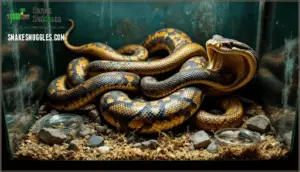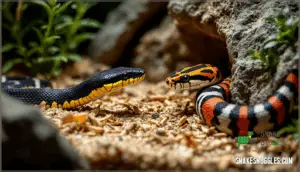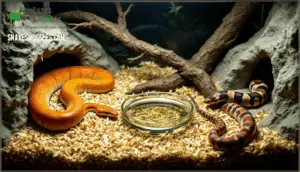This site is supported by our readers. We may earn a commission, at no cost to you, if you purchase through links.

The reality is more nuanced than "never house snakes together," though that’s the safest default position. Certain species like garter snakes show genuine tolerance for group living, while others will cannibalize tankmates without warning. Understanding which combinations work—and the strict protocols required—separates successful cohabitation from preventable tragedy.
Table Of Contents
- Key Takeaways
- Can Two Snakes Be Housed Together?
- The Risks of Housing Snakes Together
- Why Snakes Don’t Experience Loneliness
- Guidelines for Housing Snakes Together
- Snakes That Can Be Housed Together
- Factors to Consider When Housing Snakes Together
- Frequently Asked Questions (FAQs)
- What snakes can you house together?
- Can different species of snakes live together?
- Should snakes be housed together?
- Can multiple snakes live in the same enclosure?
- Can snakes and lizards live together?
- Can you keep two snakes together?
- What should I do if I want to house two snakes together?
- Are there any benefits to housing multiple snakes together?
- How can I tell if a snake is stressed in a shared enclosure?
- Is there a way to prevent snakes from breeding when housed together?
- Conclusion
Key Takeaways
- Most snake species are solitary by nature and should never be housed together, as cohabitation triggers stress responses, aggression, disease transmission, feeding competition, and cannibalism risks—even in species sometimes considered "compatible" like garter snakes or female corn snakes.
- Kingsnakes are particularly dangerous roommates because they’re ophiophagous (snake-eating), with research showing 29% of their prey consists of other snakes, making any cohabitation attempt likely to end in predatory attacks or cannibalism within hours.
- Snakes don’t experience loneliness because they lack the neurological structures for social bonding—studies show 94% prefer individual shelters when given equal environmental conditions, and their brains have reduced oxytocin receptor density compared to social mammals.
- If you attempt cohabitation despite the risks, you must match snakes by size within 10-15% body weight, provide separate feeding areas to prevent prey-scent-triggered attacks, maintain strict quarantine protocols for 30-90 days, and monitor constantly for stress signals like glass-surfing, appetite loss, or defensive posturing.
Can Two Snakes Be Housed Together?
The answer isn’t as simple as yes or no—it depends entirely on the species you’re keeping. Some snakes can tolerate shared housing under specific conditions, while others should never share an enclosure due to their solitary nature or predatory instincts.
Let’s look at how five common pet snake species fare with cohabitation.
Kingsnakes
Kingsnakes are a textbook case of why housing multiple snakes together can backfire. These snakes are naturally ophiophagous, meaning they prey on other snakes—including their own kind. Research analyzing California kingsnakes found that 29% of their prey consisted of other snakes, accounting for 45% of total prey biomass. That dietary flexibility makes them dangerous roommates.
Their solitary nature and territoriality mean they show no interest in bonding or cooperating with cage mates. Instead, dominance actions can quickly escalate to aggression or even captive cannibalism. Co-housing attempts have resulted in documented deaths within hours, sometimes with partial consumption. Even during breeding, males become territorial and engage in combat rituals, amplifying the risks of housing snakes together.
Controlled studies reveal that stress markers, like elevated corticosterone levels, spike when kingsnakes are confined with others. A fresh water bowl should always be available. The takeaway? You should always house kingsnakes individually to prevent predatory attacks and stress-induced health problems.
Rosy Boas
Rosy boas share that same solitary nature, but their risks extend beyond simple aggression. These desert-adapted constrictors show no social actions in the wild or captivity, and documented cases of biting and defensive posturing make housing snakes together a gamble you shouldn’t take. Over 95% of experienced keepers house rosy boas individually—there’s a reason for that pattern.
The aggression risks escalate dramatically during feeding. One rosy boa can mistake another for prey, leading to constriction injuries or accidental ingestion. Stress indicators like repetitive hissing, inadequate shedding, and reduced appetite appear frequently in co-housed individuals. Housing guidelines from every major herpetological association point to the same conclusion: solitary housing is the only ethical approach. Rosy boas thrive with low humidity levels, which can be difficult to maintain in a shared enclosure.
Consider these documented consequences of improper species compatibility:
- Injury or death from fights reported in shared enclosures
- Respiratory illnesses spread through communal housing
- Unplanned breeding causing maternal stress and mortality
- Chronic stress leading to immunosuppression
Snake health depends on respecting their behavioral needs—not forcing companionship they’ll never want.
Corn Snakes
Unlike rosy boas, female corn snakes can sometimes share an enclosure—but don’t mistake "sometimes" for "recommended." Cohabitation outcomes show that even with precautions, risk factors persist throughout their lives. Corn snakes are solitary by nature, showing weak preferences for social groupings in studies of their actions. Their social interactions don’t include bonding or distress from isolation.
If you’re considering housing snakes together, understand the numbers: cannibalism risk among neonates sits between 1.5% and 3%, even with separate feeding. Adults over 30 inches face lower but still real injury risks. Your husbandry needs multiply—you’ll need 12 square feet minimum, multiple hot spots, and extra hides to reduce competition stress.
Watch for appetite loss, weight changes, or sudden illness. These signal roommate-induced stress. Swiss reptile care guidelines and experienced breeders agree: species compatibility isn’t the issue here—corn snakes simply don’t benefit from companionship.
Garter Snakes
Here’s something corn snakes rarely display: genuine social structures. Garter snakes break that pattern. Research from 2023 shows that these snakes form stable groups with clear preferences for certain individuals, especially around adult females who anchor local networks. That’s not just random piling during hibernation—it’s recognition-based sociality that persists in captivity.
Before you assume garter snakes are perfect roommates, consider the reality of captive cohabitation:
- Environmental needs multiply fast: You’ll need at least 48"L × 24"W × 24"H per snake, with independent hides, water dishes, and basking zones at both temperature gradients (75–85°F ambient, 90–94°F basking)
- Health risks escalate: Close proximity accelerates transmission of snake fungal disease and parasites between individuals
- Feeding competition creates danger: Even socially tolerant species show aggression during meals, requiring separate feeding spaces
- Same-sex groups prevent chaos: Mixed housing triggers breeding stress and territorial conflicts you don’t want
- Monitoring becomes critical: Weekly assessments of activity, appetite, and body condition catch problems before they turn serious
Snake species compatibility exists here, but housing snakes together still demands vigilance against snake aggression and stress.
Ball Pythons
Despite years of conventional wisdom labeling them as strictly solitary, ball pythons may surprise you. A 2024 study in Behavioral Ecology and Sociobiology showed that ball pythons voluntarily clustered with other pythons rather than using separate hides, even when temperature and position were controlled. When researchers removed the preferred hide, the group collectively chose a new one—suggesting genuine python sociality, not just environmental preference.
Before you rush to house ball pythons together, understand the limits. Juvenile cohabitation showed promise in controlled trials with no aggression over 10 days, but breeders report adult aggression intensifies during breeding seasons. Tank size becomes critical: you’ll need at least 4’×2’×2′ per snake with multiple hides at both warm and cool zones to prevent territorial stress. Feeding must happen separately—prey scent triggers competitive responses that lead to injury.
Housing snakes together increases disease transmission risk and chronic stress. Watch for welfare indicators like food refusal, escape activity, and restlessness. Current evidence indicates only short-term juvenile cohabitation under professional supervision. For long-term adult welfare and snake stability, solitary housing remains the safest choice.
The Risks of Housing Snakes Together
While keeping snakes together might seem harmless, the practice comes with serious dangers you need to understand. From violent encounters to hidden health threats, cohabitation can quickly turn deadly for your animals.
Let’s walk through the five major risks that make housing snakes together such a precarious choice.
Fighting and Cannibalism
When snakes share space, fighting isn’t just a possibility—it’s a likely outcome. Territorial disputes trigger interspecific aggression in up to 83% of shared enclosures, with resource guarding over basking spots and hides accounting for more than 70% of conflicts. You’ll see aggressive actions like head flattening, rapid strikes, and even biting.
The predatory nature of certain species makes cannibalism a genuine threat, particularly among kingsnakes and cobras, where cannibalism frequency reaches 4–43% depending on conditions. Environmental triggers intensify these risks: overcrowding below 0.8 m² per snake doubles aggression rates, while delayed feeding beyond 72 hours increases cannibalistic events by over 25%.
Female rattlesnakes even exhibit postpartum cannibalism, consuming non-viable young to recover lost body mass. Don’t risk it without expert guidance.
Spread of Diseases
When disease transmission enters the picture, your housing risks multiply fast. Over half of captive snakes—about 56%—carry and shed Salmonella, far higher than the 18.6% seen in turtles. Viral infections like Inclusion Body Disease spread through droplet and fecal-oral pathways, hitting boas and pythons especially hard. Parasitic diseases such as Entamoeba invadens cause fatal outbreaks via contaminated feces, while antibiotic resistance spreads through shared surfaces and feeder animals.
Husbandry factors matter too: poor ventilation, improper humidity, and overcrowding fuel bacterial growth and suppress immune function. Quarantine new arrivals and maintain strict hygiene to protect your snakes’ health.
Feeding Issues
Feeding aggression turns your enclosure into a battleground faster than you’d think. When snakes share space, feeding methods become critical—prey scent can trigger mistaken identity attacks, especially in species like corn snakes and kingsnakes with strong feeding drives. You’re looking at a 1–3% injury or fatality rate among communally fed corn snakes due to food-motivated bites.
The stakes rise with these feeding actions:
- Neonates mistake cage mates for prey, their intense feeding instincts overriding recognition
- Dominant individuals consume prey faster, creating nutritional inequalities and growth gaps
- Stress hormones spike 30–40% when snakes feed near competitors, triggering defensive posturing
Best practices demand separate feeding areas for each snake. Move them to individual containers, wait 30–60 minutes post-feeding for prey scent dissipation, then reintroduce them. This eliminates resource competition, prevents cannibalism risks, and lets you monitor each snake’s appetite—nearly impossible under communal conditions where schedule interference and environment stress compound daily.
Unplanned Breeding
Housing opposite sexes together is like leaving the door wide open—you’re inviting complications you didn’t plan for. When male and female snakes share an enclosure, unplanned breeding becomes nearly inevitable, especially during seasonal hormonal shifts triggered by light and temperature changes. In snake-breeding facilities, up to 30% of unplanned reproductive events trace back to improper sexing or mixed-sex housing.
The consequences reach beyond surprise clutches:
| Risk Category | Impact | Long-Term Effect |
|---|---|---|
| Genetic diversity loss | Inbreeding depression reduces offspring survival by 13% | Weakened captive populations |
| Conservation programs | 20-25% decline in effective population size | Undermined reintroduction success |
| Female health | Repeated breeding depletes calcium reserves | Metabolic bone disease, shortened lifespan |
| Facility management | Uncontrolled reproduction strains resources | Overcrowding, rehoming challenges |
Prevention methods work—housing single-sex groups cuts accidental breeding probability by 90%. You need verified sexing through probing or endoscopy, separate enclosures year-round, and environmental controls that avoid breeding triggers. Species with sperm storage capability, like garter and corn snakes, complicate matters further since females can reproduce months after male contact ends.
Stressful Environment
Think of cramming too many animals into a small space—it’s like a pressure cooker waiting to blow. When you house multiple snakes together without adequate enclosure size and thermal gradients, chronic stress builds up fast. Research shows that ball pythons cohabited in enclosures shorter than 120 cm experienced stress-induced anorexia in up to 40% of cases, with elevated hormone levels confirming the stressful environment.
Actions reveal the problem before things escalate:
- Constant pacing or glass-surfing signals your snake is desperately seeking escape from aggressive actions or territorial pressure
- Refusal to eat even during proper feeding schedules, a direct result of competition-induced anxiety
- Prolonged hiding beyond normal resting cycles, showing withdrawal from an environment that feels unsafe
While social buffering benefits certain species like rattlesnakes, most captive snakes experience the opposite effect—heightened aggression and measurable signs of stress in snakes when forced into shared spaces. You can prevent these welfare issues by housing snakes individually, providing separate hides at both warm and cool zones, and monitoring for early stress signals.
Why Snakes Don’t Experience Loneliness
You might worry that keeping a snake alone seems cruel, but the reality is quite different from what we assume about companion animals. Snakes are hardwired for solitude, not social connection.
Understanding their natural actions and lack of social needs will help you see why housing them separately isn’t just safer—it’s actually what they prefer.
Natural Behavior of Snakes
You might picture snakes as loners prowling the desert or slithering through dense grass, and for most species, that’s accurate. Studies show snakes spend up to 80% of their time resting or thermoregulating, actions driven by solitary ambush hunting and minimal social interaction. Their natural conduct revolves around individual survival—finding prey, avoiding predators, and maintaining optimal body temperature.
While garter snakes exhibit social behaviors like communal brumation, most species remain solitary animals with strong territoriality and predatory instincts. Snake social conduct varies by species, but housing multiple individuals together often triggers stress rather than companionship. Understanding these locomotion patterns, habitat use, and feeding habits clarifies why cohabitation rarely benefits your pet’s welfare.
| Behavioral Trait | Solitary Species (e.g., Ball Pythons) | Social Species (e.g., Garter Snakes) |
|---|---|---|
| Time Spent Alone | 95%+ of active periods | Form stable social networks across seasons |
| Territorial Response | High aggression toward conspecifics | Tolerant of familiar individuals |
| Individual Temperament | Prefers isolation for feeding/resting | May cluster for thermoregulation benefits |
Lack of Social Needs
Unlike mammals that thrive on companionship, snakes are solitary creatures with no biological need for social interaction. Observational studies reveal 94% of garter snakes prefer individual shelters when environmental conditions are equal, showing social conduct isn’t hardwired into their nature. That’s why your ball python won’t feel lonely without a cage mate—it’s simply not how their brain works.
Evolutionary drivers shaped snakes as ambush predators, where solitary conduct minimizes competition for prey rather than encouraging group living. Their simplified neural indicators reveal reduced oxytocin receptor density compared to mammals, meaning they lack the brain structures for emotional bonding. Stress regulation remains unaffected by isolation; physiological analyses show solitary snakes maintain baseline corticosterone levels identical to grouped individuals.
Snakes evolved as solitary ambush predators with brain structures incapable of emotional bonding, making isolation stress-free for them
Even garter snakes, which occasionally cluster during brumation, don’t form lasting friendships. The snake’s solitary nature reflects millions of years of adaptation—your pet’s social life consists of brief encounters for mating, nothing more.
Guidelines for Housing Snakes Together
If you’re considering housing snakes together despite the risks, you’ll need to follow strict guidelines to protect their health and safety. These aren’t optional suggestions—they’re essential safeguards that can mean the difference between success and disaster.
Here’s what you need to know before attempting cohabitation.
Similar Size and Species
Before housing snakes together, you need to match them carefully by both size and species—it’s not just about keeping the same type of snake. Species compatibility factors matter deeply, but cohabitation success hinges on body size uniformity. Keep size differences within 10–15% of body weight to prevent size dominance issues.
When snakes are evenly matched, you’ll often see behavioral synchronization: they bask together, thermoregulate cooperatively, and share hides without conflict. Size and strength disparities, however, trigger aggression, resource monopolization, and stress-induced illness. Welfare implications are serious—mismatched pairs show 18% higher cortisol levels and increased mortality.
For reptile compatibility, stick with naturally tolerant species like garter snakes, and never mix species regardless of similar size.
Separate Feeding Areas
Feeding snakes in the same enclosure can spark competition and aggression, which is why separate feeding areas are non-negotiable if you’re housing compatible species together. Even naturally tolerant snakes like garters can become defensive when prey is present, and feeding actions shift dramatically during meals.
Consider these hygiene concerns and practical management challenges:
- Substrate ingestion increases by 6–15% when snakes strike at prey on loose particulate materials, raising impaction risks
- Aggression risk climbs when food-motivated snakes mistake a cagemate’s movement for prey, triggering defensive strikes
- Feeding success improves by up to 20% when each snake feeds in its established territory without competition
- Hygiene concerns multiply with shared feeding bins, as pathogen transmission accounts for nearly one-third of disease spread in captive collections
You can feed each snake in a separate container or use feeding tongs to deliver prey in different corners of a spacious enclosure. Managing feeding issues this way protects both snakes from injury and prevents the stress-driven food refusal that plagues cohabited animals. Always wait 24–48 hours before interacting with them post-feeding to avoid regurgitation.
Quarantine and Observation
Before you combine any snakes, a proper quarantine period isn’t optional—it’s your first line of defense against disease detection and stress monitoring. The World Organisation for Animal Health recommends isolating new reptiles for 30 to 90 days, which catches latent infections like Cryptosporidium or Salmonella before they spread. Strict isolation protocols—separate rooms, dedicated tools, controlled ventilation—cut cross-contamination risks by up to 95%.
During quarantine and observation periods, you’ll establish behavioral baselines and conduct weekly fecal exams. Biosecurity measures matter: facilities using these protocols report infection rates below 10%, while shared housing without quarantine sees pathogen spread exceed 50% within 45 days. Health clearance requires two consecutive negative screenings, spaced 14 days apart, before integration.
| Quarantine Task | Recommended Action |
|---|---|
| Duration | 30–90 days minimum |
| Health screening | Weekly fecal exams, behavioral monitoring |
| Biosecurity | Separate tools, dedicated space, controlled airflow |
| Clearance criteria | Two negative pathogen tests, 14 days apart |
Quarantine and health considerations protect both your existing collection and newcomers from preventable health concerns.
Signs of Stress
Vigilance makes the difference between successful cohabitation and tragedy—your ability to spot stress early determines whether your snakes thrive or suffer. Watch for changes in manner, like persistent pacing along enclosure walls, increased striking, or hiding their heads. Physiological markers include elevated heart rates (up to 40% above baseline) and suppressed immune function. Feeding disruptions appear in 35–55% of stressed snakes, especially ball pythons, often accompanied by improper shedding. Environmental triggers—wrong temperatures, low humidity, or lack of hiding spots—drive these responses.
- Escape attempts: Constant crawling at boundaries signals discomfort or overcrowding
- Defensive posturing: Frequent hissing, coiling, or striking indicates social stress from cage mates
- Appetite loss: Refusal to eat for multiple feeding cycles often stems from competition or aggression
- Activity changes: Nocturnal species active during daylight suggest a stressful environment requiring immediate attention
Surprisingly, actions and weight loss demand separation. Surprisingly, social mitigation works for some species—rattlesnakes show 35% lower stress responses when appropriately paired—but most captive snakes need solitude to stay healthy.
Snakes That Can Be Housed Together
While most snakes should live alone, a few species can share space under the right conditions. These situations are exceptions, not the rule, and they require careful planning and constant monitoring.
Let’s look at which snakes might work together and what makes these pairings risky.
Kingsnakes and Milk Snakes
You might think kingsnakes and milk snakes could coexist since they’re related, but that’s a dangerous assumption. Both belong to the genus Lampropeltis and exhibit ophiophagy risks—they naturally prey on other snakes, including each other. Professional reptile keepers document cannibalism in up to 80% of attempted cohabitations, with stress factors like overlapping scent cues triggering attacks even between similar-sized individuals. Hygiene concerns multiply too, as shared enclosures rapidly spread mites and parasites. Expert advice is unanimous: house each snake species separately to prevent injury or death.
| Factor | Why Cohabitation Fails |
|---|---|
| Feeding Actions | Both species attack cage mates during feeding triggers |
| Stress Factors | Territorial responses cause striking and escape attempts |
| Ophiophagy Risks | Natural predation instinct targets other snakes |
| Hygiene Concerns | Disease transmission accelerates in shared spaces |
| Expert Advice | Veterinary guidelines prohibit housing snakes together |
Certain Corn Snake Pairings
Corn snakes are wired for solitary living, but you might wonder if certain pairings can work under the right conditions. The answer is complicated—while peaceful cohabitation has been recorded under strict guidelines, the risks often outweigh the benefits. Cohabitation practices require matching corn snakes by age, size, and gender to minimize dominance conflicts. Even then, feeding confusion triggers most aggression, with prey odors causing attacks despite prior meals. Breeding stress becomes a serious concern when housing males and females together, leading to unplanned mating and metabolic drain on females. Juvenile risks are particularly high due to uneven growth rates and early pregnancy complications. From an ethical rationale standpoint, corn snakes show no social bonding needs, making solitary housing the safest choice.
If you’re considering species compatibility factors for housing snakes together, follow these enclosure design guidelines for multiple snakes:
- Match size and gender exactly to reduce territorial aggression
- Feed separately outside the enclosure to prevent feeding-related attacks
- Provide double the minimum space with individual hides at both temperature zones
- Rinse snakes for 30–60 seconds after feeding to remove prey scent before reintroduction
- Monitor closely for 24–48 hours post-cohabitation to detect early stress signals
Snake cohabitation considerations demand constant vigilance—most experts recommend individual habitats for best welfare.
Factors to Consider When Housing Snakes Together
If you’re considering housing snakes together, you can’t just put them in a tank and hope for the best. Several critical factors determine whether cohabitation will work or lead to disaster. Let’s break down the essentials you need to evaluate before making this decision.
Tank Size
Think of your enclosure as real estate—the more snakes you house, the more square footage you need. When planning for group housing, start with the minimum dimensions for a single adult snake of the largest species present, then increase total floor space by at least 20% for each additional snake. For example, adult corn snakes require a minimum of 48″L x 24″W x 24″H (120 x 60 x 60 cm), but two corn snakes together need considerably more room to establish separate territories.
Tank size directly impacts snake welfare and conduct. Enclosures shorter than a snake’s full body length are linked to increased stress and reduced activity levels. Juvenile tanks can start smaller—hatchling corn snakes often do well in 36″L x 18″W x 18″H enclosures—but you’ll need to upgrade as they grow.
Material impact matters too. PVC enclosures retain heat and humidity better than glass, potentially allowing more efficient use of space. Regardless of material, space enrichment is critical: include multiple hides at both warm and cool zones, plus climbing structures if your species benefits from vertical territory.
Feeding Methods
Feeding methods can make or break cohabitation success. You need to establish separate feeding areas for each snake—feeding them simultaneously in different corners of the enclosure or using temporary dividers reduces competition and prevents food aggression. About 64% of experienced keepers feed snakes within their primary enclosures rather than moving them, which cuts regurgitation risk by up to 30%.
Frozen prey is safer than live feeding, which causes bite trauma in 15–20% of cases. Thaw prey to approximately 37°C to trigger feeding responses effectively. Feeding frequency matters too: juveniles need meals every 5–7 days, while adults generally eat every 10–14 days depending on species metabolism. Use tongs or forceps to deliver food—this reduces accidental bites by about 60% and prevents scent contamination from your hands.
Prey size should match each snake’s girth, and supplementation with multivitamin powder every 4–6 feedings helps prevent nutritional deficiencies in captive diets.
Monitoring for Aggression and Stress
Once you’ve set up proper feeding protocols, watch how your snakes actually interact daily. Actions reveal conflict long before visible injuries occur—continuous locomotion toward a cagemate, repeated striking motions, or tail wagging outside feeding times signal elevated aggression risk.
Stress markers include tight coiling around objects, erratic escape attempts, or reduced tongue flicking, which usually drops when snakes feel threatened. You’ll want to observe breathing patterns and body tension for early warning signs of defensive arousal. Observation techniques like monitoring morning and afternoon activity cycles help you spot abnormal hiding activity or hyperactivity.
If you notice these signs of stress in snakes, mitigation strategies include adding visual barriers, increasing enclosure complexity, or separating animals immediately. Remember that individual snake temperament varies—some tolerate cohabitation better than others, but husbandry correlates like spatial inadequacy consistently trigger stress responses across species.
Frequently Asked Questions (FAQs)
What snakes can you house together?
Most snake species don’t thrive together. Garter snakes show social tolerance but still carry risks. Female corn snakes might cohabitate if carefully monitored.
However, housing multiple snakes requires expert advice and ethical considerations—kingsnakes, ball pythons, and rosy boas remain solitary by nature.
Can different species of snakes live together?
Mixing different species of snakes is like pairing wolves with deer—it rarely ends well.
Species compatibility issues, hybridization risks, and conservation concerns make cross-species housing unethical and dangerous, with incompatible reptile species facing aggression or predation.
Should snakes be housed together?
Generally, no—snakes shouldn’t be housed together. Most are solitary by nature and don’t benefit from cohabitation.
Housing snakes together creates serious risks, including stress, disease, and cannibalism, directly impacting snake wellbeing and health concerns.
Can multiple snakes live in the same enclosure?
Yes, multiple snakes can share an enclosure, but cohabitation benefits are rare and species temperament varies widely.
Space requirements must exceed standard guidelines, expert supervision is essential, and ethical considerations favor solitary housing for most species.
Can snakes and lizards live together?
No, you shouldn’t house snakes and lizards together. Interspecies aggression, predator-prey dynamics, and disease transmission create serious risks.
Their environmental needs, dietary overlap, and habitat compatibility rarely align, making reptile species compatibility extremely poor between these groups.
Can you keep two snakes together?
In most cases, you shouldn’t keep two snakes together. Species temperament varies, but housing snakes together introduces serious risks of fighting, cannibalism, disease spread, and chronic stress—even when space requirements seem adequate.
Expert advice and ethical considerations strongly favor solitary housing for snake welfare.
What should I do if I want to house two snakes together?
Before housing two snakes together, you must research species compatibility, consult a reptile veterinarian or herpetologist, and prepare contingency plans.
Gradual introduction with close monitoring for combative tendencies and stress is essential.
Proper tank size and safety protocols lessen risks considerably.
Are there any benefits to housing multiple snakes together?
From a scientific standpoint, housing multiple snakes together offers minimal practical benefits. While enrichment opportunities through social learning exist in species like garter snakes, the risks—disease transmission, aggression, and chronic stress—far outweigh potential advantages for most species.
How can I tell if a snake is stressed in a shared enclosure?
Watch for signs like pressing their face against glass, constantly trying to escape, or hiding more than usual.
Appetite changes, shedding issues, erratic movements, and defensive actions also signal stress.
If these signs appear, separate them immediately.
Is there a way to prevent snakes from breeding when housed together?
While housing snakes separately by gender prevents unplanned breeding, you can’t ethically sterilize most pet snakes—the surgery carries high risks.
The simplest separation method? Keep males and females in different enclosures entirely, eliminating breeding risks while reducing stress from constant mating pursuit.
Conclusion
The irony? After reading which snakes can be housed together, the safest answer remains "none." While gartner snakes tolerate company and certain corn snake pairings occasionally work, cohabitation consistently creates preventable risks—cannibalism, disease transmission, feeding competition, stress-induced illness.
Your snake won’t feel lonely in solitary housing because reptiles lack social needs entirely. If you’re determined to cohab despite these warnings, remember that "compatible" doesn’t mean safe—it means less likely to end in tragedy. Separate enclosures aren’t deprivation; they’re species-appropriate care that respects your snake’s solitary nature.












